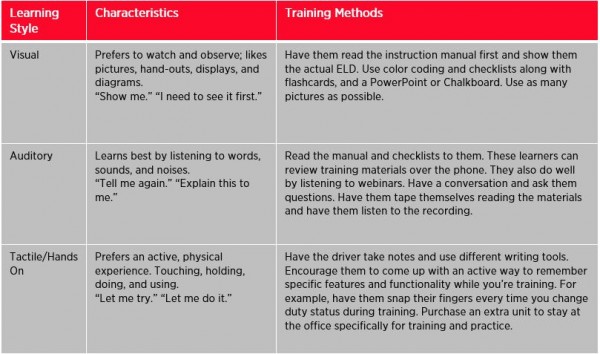Step 1: Help Drivers understand ELDs and how to use them
Drivers must understand and be able to use an ELD by the required December 16, 2019 deadline (or NOW if you aren’t operating under the AOBRD grandfather clause), including how to annotate and edit RODS, certify RODS, and show required supporting documents. They must also know how to display and transfer data to safety officials upon request.
Step 2: Review User Manual and Visor Cards
The ELD User Manual and Visor Cards must be in the cab at all times. It’s important for drivers to review these documents prior to their first ELD use so know how to transfer logs at a roadside inspection or in case of malfunctions. They may also be asked to hand over these documents to enforcement during inspection, so it’s wise to keep them in the same place in the truck.
Step 3: Train on all FMCSA-required ELD features and functions
Since drivers will be using ELDs every time they drive, make sure your team knows how to do the following:
- Log in procedures
- Responding to unassigned driving hours in ELD records
- Recording duty status changes
- Editing records
- Adding notes to records that explain edits or additions
- Certifying records are complete and accurate
- Accessing RODS data from the ELD
- Reviewing and understanding ELD printout/display information
- Transferring ELD data by email or Bluetooth® to inspectors or law enforcement
- Identifying, correcting and reporting data diagnostic issues
- Reporting ELD malfunctions
Step 4: Use your ELD vendor as a resource
Ask your ELD vendor if they have training materials designed specifically for drivers. At EROAD we have multiple resources to support drivers including how-to videos, roadside checklists, downloadable presentations and more. You can find them on our help site
Step 5: Create a plan tailored to your operations and stick to it
Now is an ideal time to evaluate your internal processes and needs for onboarding new drivers. Review your continuing education/follow-up training and Progressive Disciplinary Action Policy. Make sure you set up a program schedule for your training and hold to it. Consider your audience as you research and evaluate their learning tools.
Step 6: Understand your drivers’ learning styles and develop the most appropriate training materials for them.
No two drivers are the same, but we often find them gravitating towards three defined learning styles: Visual, Auditory, and Tactile/Hands On. The chart bellows displays a variety of identifying characteristics and supporting training methods for each style.

Step 7: Nominate a Master Trainer
Choose a Master Trainer on your driving staff and have them teach other drivers. They may be able to come up with new ways for you to communicate to your drivers. Encourage other drivers to become Master Trainers within your organization and hold contests or bonuses for completing quizzes about how to use the device in specific instances.
Training isn’t easy, but it certainly pays off. If you make and take the time to implement training your drivers properly you’ll be more likely to stay compliant out on the road while keeping your drivers happy.

